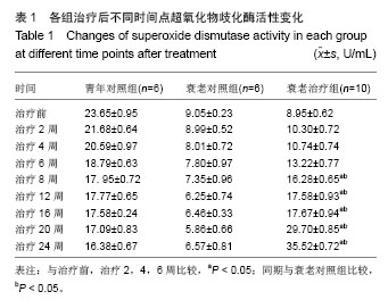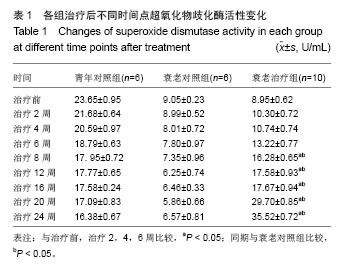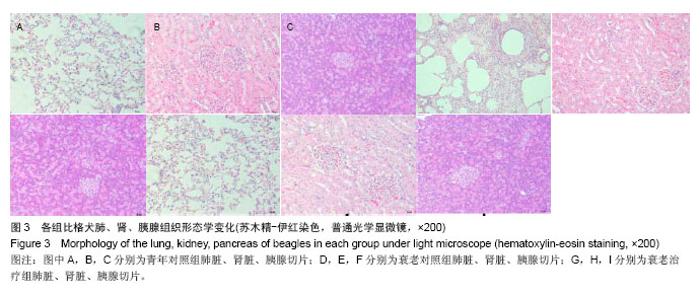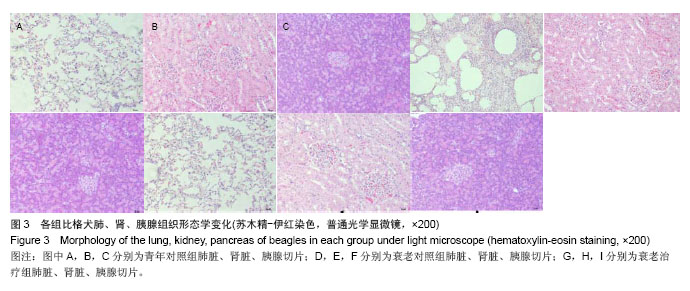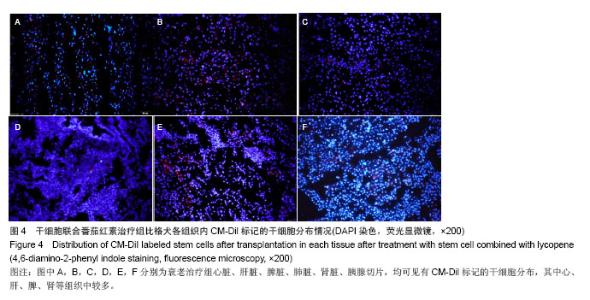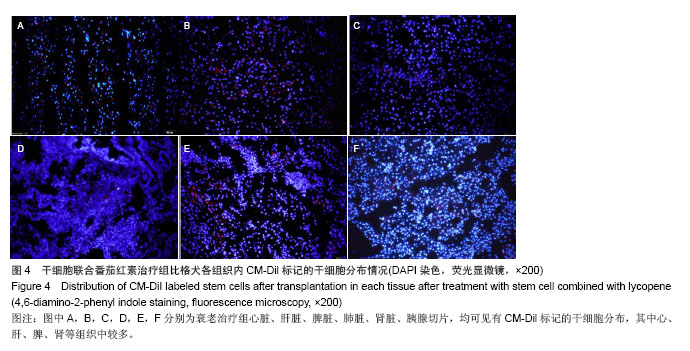Chinese Journal of Tissue Engineering Research ›› 2014, Vol. 18 ›› Issue (45): 7239-7245.doi: 10.3969/j.issn.2095-4344.2014.45.005
Previous Articles Next Articles
The anti-aging study of human umbilical cord mesenchymal stem cells combined with lycopene treatment in the aging beagles
Wang Lin-lin1, Cui Xiao-lan2, Shi Han1, Cheng Xue1, Liu Jia1, Shen Yi1, Li Qian-qian1, Wang Yi-zhong1
- 1Department of Hematology and Endocrinology, Peking University Aerospace School of Clinical Medicine, Beijing 100049, China; 2Pharmacology Laboratory, Institute of Chinese Materia Medica, China Academy of Chinese Medical Sciences, Beijing 100700, China
-
Online:2014-11-05Published:2014-11-05 -
Contact:Wang Yi-zhong, M.D., Chief physician, Department of Hematology and Endocrinology, Peking University Aerospace School of Clinical Medicine, Beijing 100049, China -
About author:Wang Lin-lin, Studying for master’s degree, Department of Hematology and Endocrinology, Peking University Aerospace School of Clinical Medicine, Beijing 100049, China
CLC Number:
Cite this article
Wang Lin-lin, Cui Xiao-lan, Shi Han, Cheng Xue, Liu Jia, Shen Yi, Li Qian-qian, Wang Yi-zhong. The anti-aging study of human umbilical cord mesenchymal stem cells combined with lycopene treatment in the aging beagles[J]. Chinese Journal of Tissue Engineering Research, 2014, 18(45): 7239-7245.
share this article
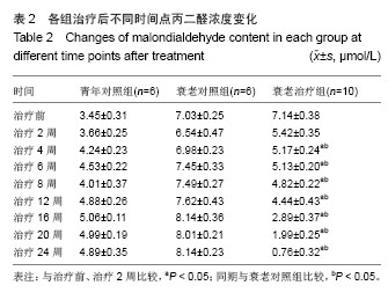
治疗8周以后,衰老治疗组超氧化物歧化酶活性逐渐升高,与治疗前、治疗2,4,6周比较,差异有显著性意义 (P < 0.001);同期各时间点衰老治疗组超氧化物歧化酶活性高于衰老对照组,与衰老对照组比较,差异有显著性意义(P < 0.05),与青年对照组比较,差异无显著性意义 (P均> 0.05)。由此可见,干细胞组联合番茄红素治疗可以显著改善自然衰老比格犬的抗氧化能力,提高超氧化物歧化酶活性。 2.5 联合治疗方法对比格犬血清丙二醛浓度的影响 如表2所示,治疗前,衰老对照组和衰老治疗组的丙二醛浓度高于青年对照组,组间统计学分析差异有显著性意义(P < 0.001),显示出自然衰老机体脂质过氧化产物增多。"
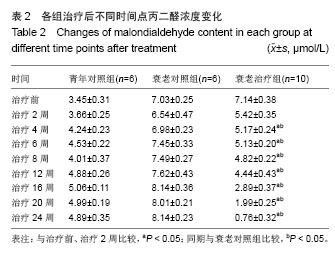
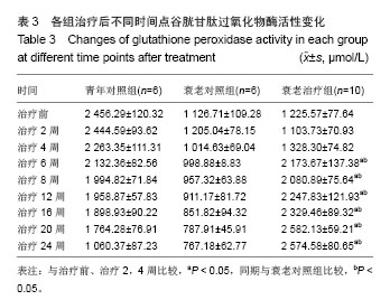
治疗4周开始,随着治疗时间延长,衰老治疗组丙二醛浓度逐渐下降,与治疗前、治疗2周比较,差异有显著性意义(P均< 0.05);同期各时间点衰老治疗组丙二醛浓度低于衰老对照组,差异有显著性意义(P均< 0.05),与青年对照组比较,差异无显著性意义(P均> 0.05)。由此可见,干细胞组联合番茄红素治疗可以显著改善自然衰老比格犬的脂质代谢及过氧化产物的状况,降低丙二醛浓度。 2.6 联合治疗方法对比格犬血清谷胱甘肽过氧化物酶活性的影响 如表3所示,治疗前,衰老对照组和衰老治疗组谷胱甘肽过氧化物酶活性均低于青年对照组,组间统计学分析差异有显著性意义(P < 0.05),显示出自然衰老机体的抗氧化能力下降,抗氧化物酶活性降低。"
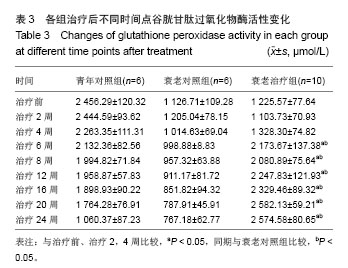
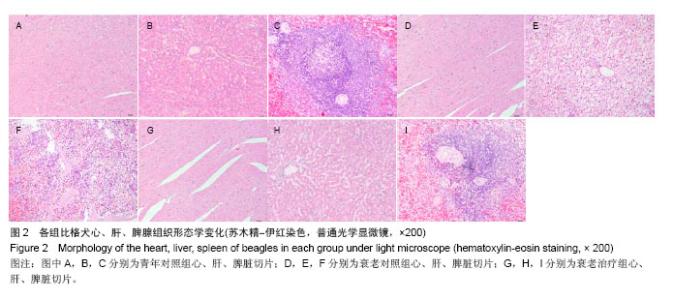
治疗6周以后,衰老治疗组谷胱甘肽过氧化物酶活性逐渐升高,与治疗前、治疗2,4周比较,差异有显著性意义 (P均< 0.05);同期各时间点衰老治疗组谷胱甘肽过氧化物酶活性高于衰老对照组,差异有显著性意义(P均< 0.05),与青年对照组比较,差异无显著性意义(P均> 0.05)。由此可见,干细胞组联合番茄红素治疗可以显著改善自然衰老比格犬的抗氧化能力,提高谷胱甘肽过氧化物酶活性。 2.7 比格犬心脏、肝脏、脾脏、肺脏、肾脏、胰腺组织病理学形态 24周后各组比格犬组织病理切片显示:衰老对照组肝脏弥漫性空泡病变;脾脏红髓内见较多炎性细胞浸润,以淋巴细胞为主;部分肺泡融合,肺间隔增宽,支气管上皮增生;偶见肾小球部分增大,余未见明显异常。而衰老治疗组和青年对照组中各组织结构轮廓清晰、正常,均未发生坏死、明显的纤维化(图2,3)。"
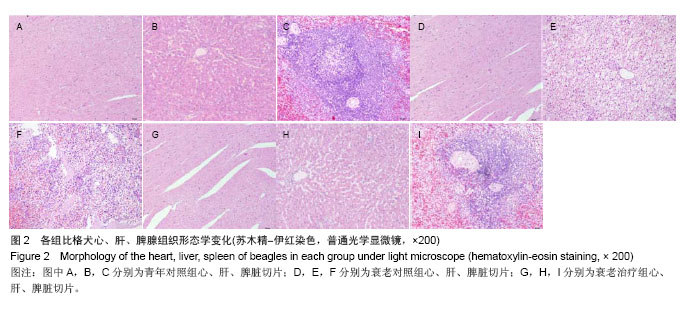
| [1]Zeng X, Rao MS.Human embryonic stem cells: long term stability, absence of senescence and a potential cell source for neural replacement.Neuroscience. 2007;145(4):1348- 1358.
[2]Campisi J.Cellular senescence as a tumor-suppressor mechanism.Trends Cell Biol. 2001;11(11):S27-31.
[3]古彦铮,强亦忠,倪祥庭,等.干细胞的衰老学说[J].中国组织工程研究与临床康复,2008,12(34):6731-6734.
[4]Tsubota K.Oxidative stress and inflammation: hypothesis for the mechanism of aging.Nihon Ganka Gakkai Zasshi. 2007; 111(3):193-205.
[5]李倩倩,崔晓兰,时瀚,等. 脐带间充质干细胞联合番茄红素的抗衰老作用[J].中国组织工程研究, 2013,17(40): 7040-7046.
[6]刘佳,王意忠,崔晓兰,等. 人脐带间充质干细胞联合番茄红素对衰老小鼠免疫功能的影响[J].中国组织工程研究, 2014,18(14): 2206-2212.
[7]王冬平,吴娜,隋丽华,等. 成年比格犬血液生理生化指标的测定[J].实验动物科学与管理,2005,22(2): 12-15.
[8]宋哲民,苑淑玲.天津市2001年医药卫生科研进展[J].医学研究通讯,2002,31(9): 32-34.
[9]白晶.动物实验"3R"原则的伦理论证[J].中国医学伦理学,2007, 20(5):48-50.
[10]Li TX, Yuan J, Chen Y,et al.Differentiation of mesenchymal stem cells from human umbilical cord tissue into odontoblast-like cells using the conditioned medium of tooth germ cells in vitro.Biomed Res Int. 2013;2013:218543.
[11]Dominici M, Le Blanc K, Mueller I,et al.Minimal criteria for defining multipotent mesenchymal stromal cells. The International Society for Cellular Therapy position statement. Cytotherapy. 2006;8(4):315-317.
[12]陈丽,吴本清,程涵蓉,等.CM-Dil体外标记人脐带间充质干细胞传代示踪的可行性[J].中国组织工程研究与临床康复, 2010, 14(40):7435-7438.
[13]Li CH, Sun L, Zhang YJ, et al.Expression of Galectins in umbilical cord mesenchymal stem cells.Beijing Da Xue Xue Bao. 2013;45(3):452-457.
[14]单莎瑞,黄国志.干细胞抗衰老的理论研究与进展[J].中国组织工程研究,2013,17(23):4347-4354.
[15]Ho AD.Kinetics and symmetry of divisions of hematopoietic stem cells.Exp Hematol. 2005;33(1):1-8.
[16]Cheng J, Türkel N, Hemati N,et al.Centrosome misorientation reduces stem cell division during ageing.Nature. 2008;456(7222):599-604.
[17]Parekkadan B, van Poll D, Megeed Z,et al.Immunomodulation of activated hepatic stellate cells by mesenchymal stem cells.Biochem Biophys Res Commun. 2007;363(2):247-252.
[18]François S, Bensidhoum M, Mouiseddine M,et al.Local irradiation not only induces homing of human mesenchymal stem cells at exposed sites but promotes their widespread engraftment to multiple organs: a study of their quantitative distribution after irradiation damage.Stem Cells. 2006;24(4): 1020-1029.
[19]Mei SH, McCarter SD, Deng Y,et al.Prevention of LPS-induced acute lung injury in mice by mesenchymal stem cells overexpressing angiopoietin 1.PLoS Med. 2007;4(9):e269.
[20]Lee HJ, Lee JK, Lee H,et al. The therapeutic potential of human umbilical cord blood-derived mesenchymal stem cells in Alzheimer's disease.Neurosci Lett. 2010;481(1):30-35.
[21]沈云东,徐建光,徐文东,等.神经干细胞移植延缓失神经肌肉萎缩的实验研究[J].中国修复重建外科杂志,2008,22(9):1051-1055.
[22]Borisov AB, Huang SK, Carlson BM.Remodeling of the vascular bed and progressive loss of capillaries in denervated skeletal muscle.Anat Rec. 2000;258(3):292-304.
[23]王黎明,周建军,白雯,等.脐带间充质干细胞治疗17例类风湿性关节炎患者的临床疗效观察[J].中国免疫学杂志, 2010,26(7): 659-662.
[24]Chang Z, Hou T, Xing J,et al.Umbilical Cord Wharton's Jelly Repeated Culture System: A New Device and Method for Obtaining Abundant Mesenchymal Stem Cells for Bone Tissue Engineering.PLoS One. 2014;9(10):e110764.
[25]Gojo S, Gojo N, Takeda Y,et al.In vivo cardiovasculogenesis by direct injection of isolated adult mesenchymal stem cells. Exp Cell Res. 2003;288(1):51-59.
[26]Xiong N, Zhang Z, Huang J,et al.VEGF-expressing human umbilical cord mesenchymal stem cells, an improved therapy strategy for Parkinson's disease.Gene Ther. 2011;18(4): 394-402.
[27]Fan CG, Zhang QJ, Zhou JR.Therapeutic potentials of mesenchymal stem cells derived from human umbilical cord.Stem Cell Rev. 2011;7(1):195-207.
[28]Glennie S, Soeiro I, Dyson PJ,et al.Bone marrow mesenchymal stem cells induce division arrest anergy of activated T cells.Blood. 2005;105(7):2821-2827.
[29]Corcione A, Benvenuto F, Ferretti E,et al. Human mesenchymal stem cells modulate B-cell functions.Blood. 2006;107(1):367-372.
[30]Ponte AL, Marais E, Gallay N,et al.The in vitro migration capacity of human bone marrow mesenchymal stem cells: comparison of chemokine and growth factor chemotactic activities.Stem Cells. 2007;25(7):1737-1745.
[31]徐小红,王力,张宁坤,等.Apelin-13对5-Aza诱导脐带间充质干细胞向心肌细胞分化的影响[J].解放军医学杂志, 2013,39(10): 796-800.
[32]Neves D, Santos J, Tomada N,et al.Aging and orchidectomy modulate expression of VEGF receptors (Flt-1 and Flk-1) on corpus cavernosum of the rat.Ann N Y Acad Sci. 2006;1067: 164-172.
[33]陈丽萍,何书英.番茄红素的抗氧化活性[J].华西药学杂志,2008, 23(6):653-655.
[34]赵娟娟.番茄红素的抗氧化活性研究[J].食品科技,2010,35(7): 62-65.
[35]Briviba K, Kulling SE, Möseneder J,et al.Effects of supplementing a low-carotenoid diet with a tomato extract for 2 weeks on endogenous levels of DNA single strand breaks and immune functions in healthy non-smokers and smokers.Carcinogenesis. 2004;25(12):2373-2378.
[36]Breinholt V, Lauridsen ST, Daneshvar B,et al.Dose-response effects of lycopene on selected drug-metabolizing and antioxidant enzymes in the rat.Cancer Lett. 2000;154(2): 201-210.
[37]曹钰,姚尧.番茄红素对大鼠局灶性脑缺血损伤的影响[J].华西药学杂志,2006,21(1):45-46.
[38]Kemp K, Gray E, Mallam E,et al.Inflammatory cytokine induced regulation of superoxide dismutase 3 expression by human mesenchymal stem cells.Stem Cell Rev. 2010;6(4): 548-559.
[39]王宏兰,盛学东,张梅,等.骨髓间充质干细胞对D-半乳糖衰老模型小鼠的实验研究[J].中国当代医药,2009,16(8):5-7.
[40]王翔,海泉,郑榆坤,等.脐带间充质干细胞对D-半乳糖衰老模型小鼠的抗衰老实验研究[J].中国现代医学杂志,2012,22(3):21-25.
[41]Ahn SY, Chang YS, Kim SY,et al.Long-term (postnatal day 70) outcome and safety of intratracheal transplantation of human umbilical cord blood-derived mesenchymal stem cells in neonatal hyperoxic lung injury.Yonsei Med J. 2013;54(2): 416-424.
[42]Zhang Z, Lin H, Shi M,et al.Human umbilical cord mesenchymal stem cells improve liver function and ascites in decompensated liver cirrhosis patients.J Gastroenterol Hepatol. 2012;27 Suppl 2:112-120.
[43]Zhang Z, Fu J, Xu X,et al.Safety and immunological responses to human mesenchymal stem cell therapy in difficult-to-treat HIV-1-infected patients.AIDS. 2013;27(8):1283-1293.
[44]Ji F, Duan HG, Zheng CQ,et al.Comparison of chloromethyl-dialkylcarbocyanine and green fluorescent protein for labeling human umbilical mesenchymal stem cells.Biotechnol Lett. 2014. [Epub ahead of print].
[45]尹飞,郭丽,孟春阳,等.CM-Dil体外标记骨髓间充质干细胞及其在烧伤大鼠模型肠组织内的示踪[J].吉林大学学报:医学版, 2012, 38(2):211-215. |
| [1] | Min Youjiang, Yao Haihua, Sun Jie, Zhou Xuan, Yu Hang, Sun Qianpu, Hong Ensi. Effect of “three-tong acupuncture” on brain function of patients with spinal cord injury based on magnetic resonance technology [J]. Chinese Journal of Tissue Engineering Research, 2021, 25(在线): 1-8. |
| [2] | Wang Shiqi, Zhang Jinsheng. Effects of Chinese medicine on proliferation, differentiation and aging of bone marrow mesenchymal stem cells regulating ischemia-hypoxia microenvironment [J]. Chinese Journal of Tissue Engineering Research, 2021, 25(7): 1129-1134. |
| [3] | He Li, Tian Wei, Xu Song, Zhao Xiaoyu, Miao Jun, Jia Jian. Factors influencing the efficacy of lumbopelvic internal fixation in the treatment of traumatic spinopelvic dissociation [J]. Chinese Journal of Tissue Engineering Research, 2021, 25(6): 884-889. |
| [4] | Liu Zhao, Xu Xilin, Shen Yiwei, Zhang Xiaofeng, Lü Hang, Zhao Jun, Wang Zhengchun, Liu Xuzhuo, Wang Haitao. Guiding role and prospect of staging and classification combined collapse prediction method for osteonecrosis of femoral head [J]. Chinese Journal of Tissue Engineering Research, 2021, 25(6): 929-934. |
| [5] | Ruan Guangping, Yao Xiang, Liu-Gao Miyang, Cai Xuemin, Li Zian, Pang Rongqing, Wang Jinxiang, Pan Xinghua. Umbilical cord mesenchymal stem cell transplantation for traumatic systemic inflammatory response syndrome in tree shrews [J]. Chinese Journal of Tissue Engineering Research, 2021, 25(25): 3994-4000. |
| [6] | Yi Meizhi, Luo Guanghua, Xiao Yawen, Hu Rong, Chen Xiaolong, Zhao Heng. MRI findings of anatomical variations of the talus [J]. Chinese Journal of Tissue Engineering Research, 2021, 25(24): 3888-3893. |
| [7] | Xie Jingshu, Zhang Xianglin, Liu Jinlei, Wen Jing. Application of High Resolution reconstruction algorithm in precision CT scans of the middle and inner ears [J]. Chinese Journal of Tissue Engineering Research, 2021, 25(23): 3614-3618. |
| [8] | Yu Yinghao, Zhao Jijun, Liu Dongcheng, Chen Yuhao, Feng Dehong. Clinical significance of preoperative planning assisted unicompartmental knee arthroplasty with digital imaging system for fixed-bearing prosthesis [J]. Chinese Journal of Tissue Engineering Research, 2021, 25(21): 3324-3331. |
| [9] | Dong Liping, Luo Huaiqing, Yuan Heng, Long Juan, Xu Shaohui. Effect of aging on collateral vessel growth in rats with ischemic hind limbs [J]. Chinese Journal of Tissue Engineering Research, 2021, 25(20): 3156-3161. |
| [10] | Liu Xing, Wei Xiaohan, Deng Jie, Li Zhongming . Preparing a blunt contusion model of rabbit skeletal muscle under different blow strengths [J]. Chinese Journal of Tissue Engineering Research, 2021, 25(2): 196-200. |
| [11] | Du Xueting, Yang Yang, Huang Wenhua, Chen Wubiao. Clinical application and breakthrough of three-dimensional printing based on medical imaging technology [J]. Chinese Journal of Tissue Engineering Research, 2021, 25(18): 2887-2894. |
| [12] | Chen Xiaolong, Zhao Heng, Hu Rong, Luo Guanghua, Liu Jincai . Correlation of infrapatellar fat pad edema with trochlear and patellofemoral joint morphology: MRI evaluation [J]. Chinese Journal of Tissue Engineering Research, 2021, 25(15): 2410-2415. |
| [13] | Han Ningning, Zuo Jinfu, Sun Miao, Tang Shengjian, Liu Fangjun. Application and progress of umbilical cord mesenchymal stem cells in bone tissue engineering [J]. Chinese Journal of Tissue Engineering Research, 2021, 25(13): 2079-2086. |
| [14] | Ma Long, Tan Xiaoxin, Sun Guoshao. A 5-year follow-up on sagittal alignment and radiological outcomes of consecutive three-level anterior cervical discectomy and fusion and hybrid surgery [J]. Chinese Journal of Tissue Engineering Research, 2021, 25(12): 1879-1885. |
| [15] | Gu Jingjing, Zhou Rui, Yang Tingting, Yang Xiaoping, Xu Fei, Zheng Bo. Supporting effect of human skeletal muscle-derived myoendothelial cells on hematopoietic stem/progenitor cells in vitro [J]. Chinese Journal of Tissue Engineering Research, 2021, 25(1): 50-55. |
| Viewed | ||||||
|
Full text |
|
|||||
|
Abstract |
|
|||||


